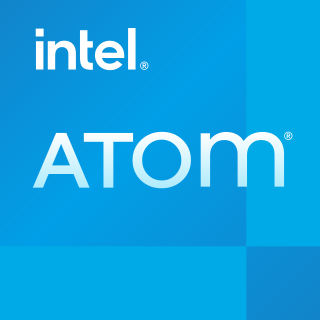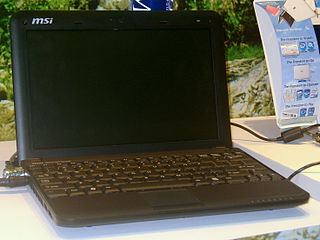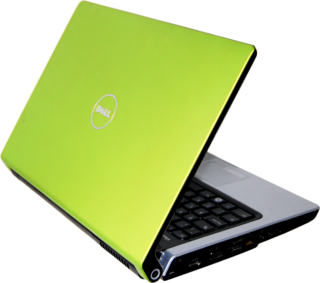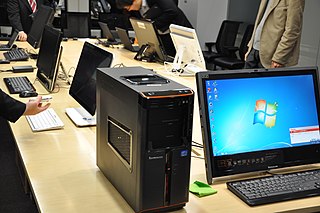Related Research Articles

A desktop computer is a personal computer designed for regular use at a stationary location on or near a desk due to its size and power requirements. The most common configuration has a case that houses the power supply, motherboard, disk storage ; a keyboard and mouse for input; and a monitor, speakers, and, often, a printer for output. The case may be oriented horizontally or vertically and placed either underneath, beside, or on top of a desk.
In computing, instant-on is the ability to boot nearly instantly, allowing to go online or to use a specific application without waiting for a PC's traditional operating system to launch. Instant-on technology is today mostly used on laptops, netbooks, and nettops because the user can boot up one program, instead of waiting for the PC's operating system to boot. This allows a user to launch a single program, such as a movie-playing program or a web browser, without the need of the whole operating system. There still remain a few true instant-on machines such as the Atari ST, as described in the Booting article. These machines had complete Operating Systems resident in ROM similar to the way in which the BIOS function is conventionally provided on current computer architectures. The "instant-on" concept as used here results from loading an OS, such as a legacy system DOS, with a small hard drive footprint. Latency inherent to mechanical drive performance can also be eliminated by using Live USB or Live SD flash memory to load systems at electronic speeds which are orders of magnitude faster.

Small form factor is a term used for desktop computers and for some of its components, chassis and motherboard, to indicate that they are designed in accordance with one of several standardized computer form factors intended to minimize the volume and footprint of a desktop computer compared to the standard ATX form factor.

Everex Systems, Inc., is a defunct American manufacturer of multi-processor servers, desktop and notebook personal computers. It was established in 1983 and headquartered in Fremont, California. The company was founded by Steve Hui, John Lee and Wayne Cheung. In 1988, Everex was the leader in tape backup sales with half of the world market. On January 5, 1993 the company filed for bankruptcy and was purchased by Formosa Plastics Group, hence becoming part of a multinational conglomerate alongside companies like First International Computer, the world's leading motherboard manufacturer. On December 29, 2006 Everex Systems, Inc filed a voluntary petition for liquidation under Chapter 7, and in June 2008 NewMarket Technology has taken control of Everex.

Zonbu was a technology company that markets a computing platform which combines a web-centric service, a small form factor PC, and an open source based software architecture. Zonbu was founded by Alain Rossmann and Gregoire Gentil.

Asus Eee is a family of products by AsusTek Computer Inc. The product family began with the release of the Eee PC subnotebook in 2007; since then, the product family has diversified into a number of PC form factors. According to the company, the name Eee derives from "the three Es," an abbreviation of its advertising slogan for the device: "Easy to learn, Easy to work, Easy to play".

Intel Atom is a line of IA-32 and x86-64 instruction set ultra-low-voltage processors by Intel Corporation designed to reduce electric consumption and power dissipation in comparison with ordinary processors of the Intel Core series. Atom is mainly used in netbooks, nettops, embedded applications ranging from health care to advanced robotics, mobile Internet devices (MIDs) and phones. The line was originally designed in 45 nm complementary metal–oxide–semiconductor (CMOS) technology and subsequent models, codenamed Cedar, used a 32 nm process.

The fit-PC is a small, light, fan-less nettop computer manufactured by the Israeli company CompuLab.

The MSI Wind Netbook was a family of subnotebooks / netbooks designed by Micro-Star International (MSI). Wind stands for "Wi-Fi Network Device". The first model was announced at CeBIT 2008, and first listed for pre-orders on May 9, 2008. While initially 8.9- and 10.1-inch screen versions existed, as of 2010 only the 10.1" remained, with a resolution of 1024 × 600. While most models had 1 GB of RAM, some had 2 GB, and hard disks ranged from 80 GB on the oldest to 250 GB on the newest models. Also featured were Bluetooth, WLAN and a 1.3 megapixel camera. The Wind PC was MSI's response to the successful Asus Eee PC. The keyboard was 92% of full-size.

Moblin, short for 'mobile Linux', is a discontinued open source operating system and application stack for Mobile Internet Devices (MIDs), netbooks, nettops and embedded devices.

Asus EeeBox PC is a nettop computer line from ASUSTeK Computer Incorporated, and a part of the Asus Eee product family. First released on August 11, 2008, the Asus EeeBox PC series is marketed as a small, light, inexpensive and energy-efficient counterpart to the Asus Eee PC netbook / subnotebook laptop series. Its motherboard employs Splashtop technology called Express Gate by Asus.

Dell Studio is a range of laptops and desktops targeted at the mainstream consumer market, produced by Dell. The computers sit above Dell's Inspiron and below the XPS consumer lines in terms of price and specifications. They differ from Dell's lower-end Inspiron models by offering slot-loading optical drives, media keys, more cover design options, faster processor options, HDMI and eSATA ports, LED-backlit screens, and backlit keyboards.

A mini PC is a small-sized, inexpensive, low-power, legacy-free desktop computer designed for basic tasks such as web browsing, accessing web-based applications, document processing, and audio/video playback.
Nvidia Ion was a product line of Nvidia Corporation intended for motherboards of low-cost portable computers. It used graphics processing units and chipsets intended for small products.

The Acer AspireRevo was a line of nettop computers from Acer Inc., first released at the end of April 2009. It is one of the first desktop computers to pair the NVIDIA ION chipset with Intel's Atom CPU.
Bonnell is a CPU microarchitecture used by Intel Atom processors which can execute up to two instructions per cycle. Like many other x86 microprocessors, it translates x86 instructions into simpler internal operations prior to execution. The majority of instructions produce one micro-op when translated, with around 4% of instructions used in typical programs producing multiple micro-ops. The number of instructions that produce more than one micro-op is significantly fewer than the P6 and NetBurst microarchitectures. In the Bonnell microarchitecture, internal micro-ops can contain both a memory load and a memory store in connection with an ALU operation, thus being more similar to the x86 level and more powerful than the micro-ops used in previous designs. This enables relatively good performance with only two integer ALUs, and without any instruction reordering, speculative execution or register renaming. A side effect of having no speculative execution is invulnerability against Meltdown and Spectre.
The Lenovo IdeaCentre Q series are a line of nettop computers meant primarily for home and personal use. The Q Series nettops are described by the manufacturer as being multimedia-oriented nettops. Comparing the size to a typical paperback book, Lenovo describes the Q Series nettops as the smallest desktops in production. The general features of the Q Series desktops are the small size, low energy requirements, ability to play HD video, and low noise levels.

The Lenovo IdeaCentre is a line of consumer-oriented desktop computers designed, developed and marketed by Lenovo. The first IdeaCentre desktop, the IdeaCentre K210, was announced by Lenovo on June 30, 2008 as a consumer-focussed alternative to the business-oriented ThinkCentre and ThinkStation brandnames acquired from IBM. While the IdeaCentre line consists entirely of desktops, they share a common design language with the IdeaPad line of laptops and hybrids. One such feature is Veriface facial recognition technology.

CuBox and CuBox-i are series of small and fanless nettop-class computers manufactured by the Israeli company SolidRun Ltd. They are all cube-shaped and sized at approximately 2 × 2 × 2 inches and weigh 91 grams. CuBox was first announced in December 2011 and began shipping in January 2012, initially being marketed as a cheap open-source developer platform for embedded systems.
References
- ↑ MSI Wind PC – Save Energy, Reduce Noise Best Solution for your 24-hour Computing Needs Archived 2009-02-01 at the Wayback Machine
- ↑ "MSI Wind desktops to hit Europe and Asia in September". Engadget. 30 June 2008.
- ↑ "MSI Computer Corp. - Product". Archived from the original on 2009-03-22. Retrieved 2009-08-04.
- ↑ MSI Unveils the first "Dual-Core" Mini System, Wind NetTop D130 Archived 2009-01-17 at the Wayback Machine
- ↑ "MSI USA".
